770 Short Face--Short Life
CHURCHILL’ S MENACE: SHORT FACE - LIMITED LIFE
by David Hancock
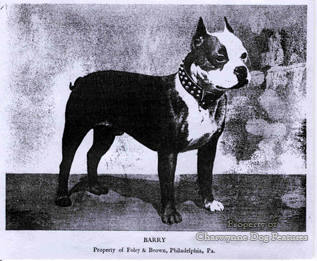 Our national symbol in wartime was Churchill, his grittiness, staunchness and sheer bloodymindedness. In peacetime we now have another ‘Churchill’ – a lovable Bulldog used by an insurance company as their symbol, but with a hidden menace. ‘Churchill’, the insurance dog, has no muzzle; at a time when veterinary experts are shouting out the danger from brachycephalic head shapes, this is inexcusable. ‘Churchill’ is a national menace, aided and abetted in TV ads by actor, Martin Clunes, allegedly a dog-lover. The public find ‘Churchill’ appealing and think all Bulldogs have to resemble him. If they do they will live a difficult life, and a short one.
Our national symbol in wartime was Churchill, his grittiness, staunchness and sheer bloodymindedness. In peacetime we now have another ‘Churchill’ – a lovable Bulldog used by an insurance company as their symbol, but with a hidden menace. ‘Churchill’, the insurance dog, has no muzzle; at a time when veterinary experts are shouting out the danger from brachycephalic head shapes, this is inexcusable. ‘Churchill’ is a national menace, aided and abetted in TV ads by actor, Martin Clunes, allegedly a dog-lover. The public find ‘Churchill’ appealing and think all Bulldogs have to resemble him. If they do they will live a difficult life, and a short one.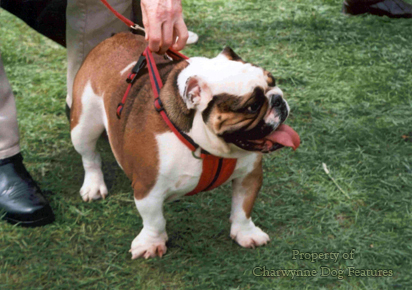
There is much opposition from dog-breeders to the European Convention on Pet Animals that seeks to limit exaggerated features in dogs, to the detriment of their health. One element in this seeking of healthier dogs is the focus placed on the 'short-faced' breeds, such as the Bulldog, the Pug, the Pekingese, the Boston Terrier and the French Bulldog. One of the problems in these breeds is that today's specimens are shorter in the face than the prototypal ones; the show-ring has produced a shorter face in these breeds than is typical. There is no shortage of medical evidence to prove that the short face in dogs brings with it a wide range of disadvantages. Difficulties in breathing, giving birth, keeping cool and coping in stressful conditions are well documented, but there are other significant anatomical problems too.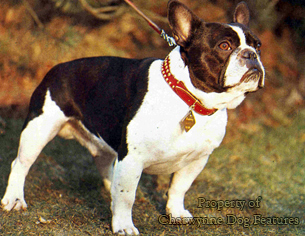
In their book, Dogs (Scribner, 2001), the Coppingers write on the Bulldog: 'Their faces are so squashed that the turbinate bones in their nostrils are tiny. Turbinate bones are covered with respiratory epithelial tissue, which helps the dog to breathe and cools its brain. As a result of the tiny turbinates, bulldogs and the other flat-facers have poor brain cooling, poor breathing, and low oxygen tension in their blood'. In their authoritative 'Breed Predispositions to Disease in Dogs and Cats' (Blackwell, 2004), Gough and Thomas devote more words to the Bulldog than any other breed, stating that brachycephalic upper airway syndrome (BAOS) is common in the breed (and in the Boston Terrier, Pekingese and Pug), with 55% of cases of hypoplastic trachea being found in this breed.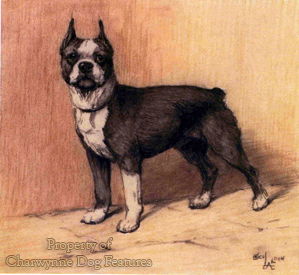
The short-faced or brachycephalic head shape is the result of an inherited defect in development of the bones of the base of the skull; the skull is of normal width but is significantly reduced in length. The soft tissues of the head are not proportionately reduced, so too much tissue is crammed into the space available, leaving little space for the passage of air. Other breeds show this defect through having too deep a stop, e.g. American Cocker Spaniels, St Bernards and some Boxers, but to a lesser extent. Bulldogs often have elongated soft palate. Bullbitches have an unusually hard time whelping, with one study stating that only 6% of Bullbitches whelp naturally. The seeking of a relatively large head in this breed contributes to this, with the head shape not helping.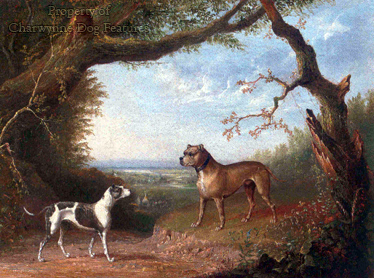
The short face also imposes scenting limitations, with such a construction imposing a loss of 80% of scenting ability. With scenting power meaning as much to dog as sight to us, this is comparable to a loss of 80% of sight in a human being, some handicap. Eye problems occur in dogs with the short face; Boston Terriers can suffer from outward turning of the eyes, making it difficult to achieve binocular vision, as well as protrusion of the eyeballs, which can lead to their eyes popping out of their sockets, from even moderate trauma. The Pug, with shortened nasal passages, suffers from chronic sinusitis and other respiratory infections. Some Pug owners actually find their dog's snoring 'comforting' !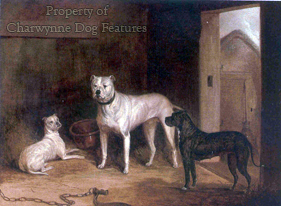
Breeding dogs for the psychological needs of humans is not very admirable but I've read of Pekingese owners liking the look of a permanently 'crying' pet and of pop-eyed breeds being desired because they look vulnerable, and they are! Eyeballs which protrude excessively expose the eye to drying, even difficulty in closing the eyes properly, and risking corneal injury. Too short a muzzle also leads to dental problems; the upper and lower jaws are not equal in length and the jaw is so short that the teeth are overcrowded. The short face also results in skin problems; deep folds or wrinkles around the nose attract bacterial infection, leading to surgical removal of some folds. Folds around the mouth tend to trap saliva and debris, causing at least a foul smell, at worst dermatitis.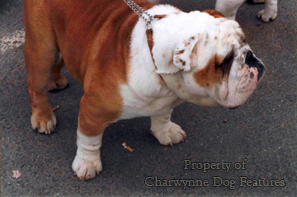
The short face in the Bulldog and derivative breeds, like the Bullmastiff, comes from the Pug cross not from the baiting ring. Following the banning of bull-baiting in 1835, the bull- baiting dogs not surprisingly suffered a decline. From 1840 the breed of Bulldog changed from a mainly white, rat-tailed, thick-eared, broad-mouthed, strongly muzzled, hard muscled canine gladiator into a very different animal. In his "The Bulldog --a Monograph" of 1899, Edgar Farman notes that: "From that time forward the breed began to deteriorate, and, with the era of modern dog shows, the appearance of an up-to-date specimen became a caricature of the active and plucky animal that baited the bull."
This caricature had been obtained by using the blood of a short-nosed, compact, close-knit, cobby, unaggressive, black- masked, smaller dog called a Pug. Outcrossing can boost a breed's virility and correct faults imposed by close breeding, but breeding for exaggeration can never be wise. The 19th century Bulldog breeder who promoted the sale of his pups by boasting that he had bred 'the shortest faced Bulldogs in London' epitomises those breeders who see merit, and profit, in exaggeration, exaggeration which harms dogs and restricts their lives, but fattens the breeders' wallets. Such breeding has to stop. We must now face up to our responsibilities.